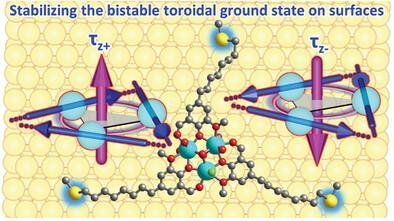Surface Stabilization to Enhance Single Molecule Toroidal Behavior in {Dy3} Molecules: the Impact of Au(111), MgO, and Graphene Surfaces
IF 13
2区 材料科学
Q1 CHEMISTRY, MULTIDISCIPLINARY
引用次数: 0
Abstract
Single-molecule toroids (SMTs), with vortex-like magnetic anisotropy axes, hold promise for quantum technologies, but controlling their toroidal states on the surface remains challenging. To address this, the SMT behavior of [Dy3(µ3-OH)2L3Cl(H2O)5]Cl3 (where L = ortho-vanillin) grafted onto Au(111), MgO has been studied, and graphene surfaces in pristine form (1) and with pyrene (2) and (CH2)8S (3) linkers, using periodic density functional theory and ab initio CASSCF/RASSI-SO methods. Both pristine and chemically functionalized molecules are stable on Au(111) and graphene surfaces; however, functionalization provides higher binding energies and, in some cases, enhances the SMT properties. The MgO surface, however, is found to be unsuitable as it abstracts an H atom from the molecule, leading to the loss of its SMT characteristics. The energy gap (ΔE) between the toroidal (nonmagnetic) and spin-flip (magnetic) states in complex 1 on Au(111) and graphene surfaces are 6.9 and 6.6 cm−1, respectively. Complexes 2 on Au(111) and 3 on graphene exhibit ΔE and toroidal blocking fields of 9.8 cm−1/1.2 T and 6.8 cm−1/0.83 T, respectively, representing the highest recorded values for this class of SMTs. These findings demonstrate the potential of surface stabilization to improve the functionality and applicability of SMTs in advanced quantum technologies.

求助全文
约1分钟内获得全文
求助全文
来源期刊

Small
工程技术-材料科学:综合
CiteScore
17.70
自引率
3.80%
发文量
1830
审稿时长
2.1 months
期刊介绍:
Small serves as an exceptional platform for both experimental and theoretical studies in fundamental and applied interdisciplinary research at the nano- and microscale. The journal offers a compelling mix of peer-reviewed Research Articles, Reviews, Perspectives, and Comments.
With a remarkable 2022 Journal Impact Factor of 13.3 (Journal Citation Reports from Clarivate Analytics, 2023), Small remains among the top multidisciplinary journals, covering a wide range of topics at the interface of materials science, chemistry, physics, engineering, medicine, and biology.
Small's readership includes biochemists, biologists, biomedical scientists, chemists, engineers, information technologists, materials scientists, physicists, and theoreticians alike.
 求助内容:
求助内容: 应助结果提醒方式:
应助结果提醒方式:


